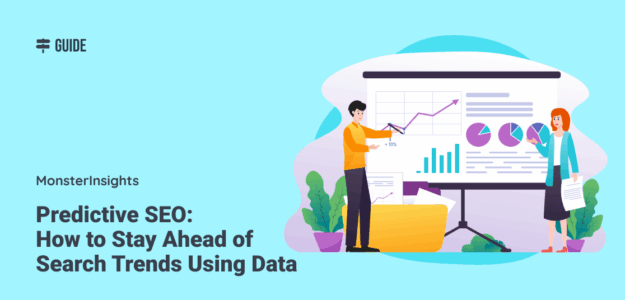Ever feel like you’re always playing catch-up with SEO? You optimize a page, publish great content, then, all of a sudden, an algorithm update changes everything. Or worse, you finally rank for a keyword right as the trend starts to fade.
What if you could see what’s coming next in search before your competitors do?
That’s exactly what predictive SEO helps you do. Instead of reacting to every Google update or scrambling to catch trending keywords after they peak, predictive SEO uses data, analytics, and AI to forecast what people will search for next. This way, you can prepare your content strategy ahead of time.
In this guide, I’ll walk you through everything you need to know about predictive SEO. You’ll learn what it is, why it matters more than ever in 2025, how it actually works, and most importantly, how to start using it on your WordPress site without any coding or complicated analytics tools.
In This Article
What Is Predictive SEO?
Predictive SEO is a proactive approach to search engine optimization that uses data analysis, historical trends, and AI insights to forecast future search behavior and ranking opportunities. Instead of waiting to see what’s working after the fact, predictive SEO helps you anticipate what your audience will search for next. That way you can create and optimize content before those trends peak.
Whereas traditional SEO is like driving while looking in the rearview mirror, predictive SEO is like having a GPS that shows you what’s ahead on the road, so you can plan your route before you get there.
Here’s an example to think about how predictive SEO works in practice. Let’s say you run an online store that sells eco-friendly products. By analyzing your Google Analytics data and Search Console queries over several months, you notice that searches for “compostable packaging” are slowly but steadily increasing. The search volume is still relatively low, but the trend is clearly upward.
With predictive SEO, you would:
- Create comprehensive content about compostable packaging now.
- Optimize product pages with related keywords.
- Build internal linking structure around this topic.
- Prepare additional resources and guides.
By the time “compostable packaging” becomes a high-volume search term, you’ve already established topical authority. You’d rank faster, capture more traffic, and beat competitors who waited until the keyword was already competitive.
The key difference between predictive SEO and traditional SEO is the timing and data-driven forecasting. Traditional SEO responds to current data. Predictive SEO uses that same data to anticipate what comes next.
The good news is you don’t need expensive tools or a data science degree to get started. Tools you’re probably already using, like Google Analytics, Search Console, and your website analytics, contain all the predictive insights you need. You just need to know what to look for.
Why Predictive SEO Matters in 2025
The SEO landscape has changed dramatically, and relying solely on reactive optimization strategies isn’t enough anymore. Here’s why predictive SEO has become essential for anyone serious about growing their organic traffic.
Search is More Dynamic Than Ever
Google’s algorithm isn’t just updating a few times a year anymore. Between core updates, helpful content updates, spam updates, and the introduction of AI-powered search experiences like Search Generative Experience (SGE) and Gemini, the search landscape is constantly shifting.
What worked last quarter might not work this quarter. What ranks today could drop tomorrow. Predictive SEO helps you stay ahead of these shifts by identifying patterns in your data that signal upcoming changes in user behavior and search intent.
User Behavior Keeps Evolving
The way people search continues to change rapidly. Voice search, mobile-first browsing, visual search, and conversational AI queries are all reshaping what people type into search boxes and what they expect to find.
By analyzing trends in your own analytics data, you can spot these behavioral shifts early and adapt your content strategy before your competitors catch on.
Competition for Rankings is Fierce
Here’s a hard truth: by the time everyone knows about a trending keyword, it’s already too competitive. The websites that win are the ones that identified and optimized for that keyword months earlier, before the rush.
Predictive SEO gives you that competitive advantage. You’re not fighting for scraps, you’re claiming territory before anyone else realizes it’s valuable.
Benefits of Predictive SEO
Here are the key benefits of adopting a predictive SEO approach:
- Capture Early Traffic Before Competitors: Be the first to rank for emerging keywords and topics, giving you a head start on building authority and capturing search traffic.
- Future-Proof Your Content Strategy: By understanding where search behavior is heading, you can create content that remains relevant through algorithm updates instead of constantly scrambling to adapt.
- Improve Marketing ROI: Stop wasting time and resources on declining keywords. Invest your efforts in content and optimization that’s likely to trend upward, maximizing your return on every hour you spend on SEO.
- Build Topical Authority in Emerging Areas: Establish yourself as an authority in your niche by covering topics before they become mainstream, which helps you rank faster when competition increases.
- Make Smarter Content Decisions: Use data to guide your content calendar instead of guessing. Know which topics to prioritize, which pages to update, and where to focus your link-building efforts.
The bottom line? Reactive SEO keeps you busy but never ahead. Predictive SEO helps you work smarter, not harder, by showing you where to focus your energy for maximum impact.
Predictive SEO Strategies You Can Start Using Today
Ready to put predictive SEO into practice? Here are six actionable strategies you can implement right away, even if you’re just getting started with data-driven SEO.
1. Analyze Keyword Trends Over Time
One of the simplest ways to spot predictive opportunities is by tracking how your keywords perform over time instead of just looking at current rankings.
The best place to start is with Google Search Console data. If you’re checking Search Console monthly, look specifically at “rising queries” — these are search terms that are gaining impressions even if they don’t have high volume yet.
For example, if you notice a keyword going from 50 impressions per month to 150 impressions per month over three months, that 200% growth is a signal worth paying attention to — even if 150 impressions seems small compared to your top keywords.
The easiest way to track keyword trends in WordPress
If you’re using WordPress, MonsterInsights brings your Search Console data directly into your dashboard, making it incredibly simple to spot these rising opportunities.
Navigate to Insights » Reports in your WordPress dashboard, then click on the Search Console tab. There, you’ll see your top 50 search queries along with clicks, impressions, click-through rate, and average position.
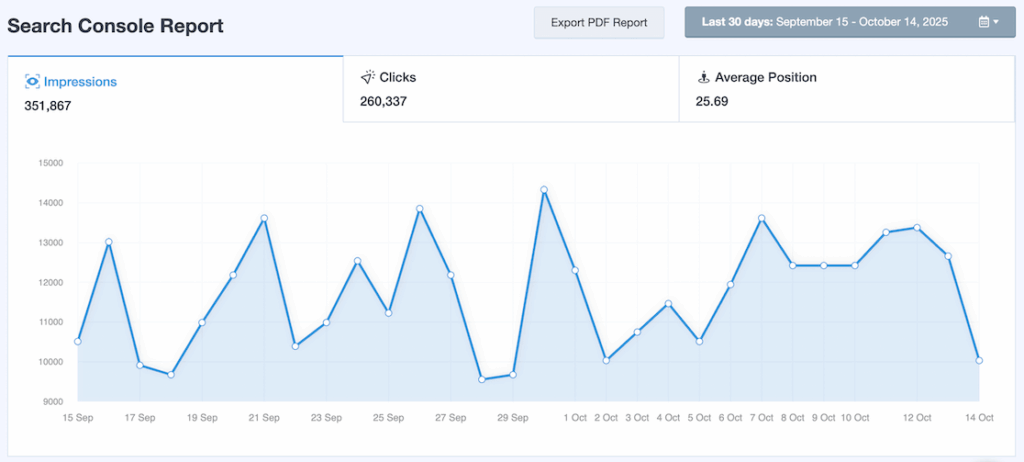
The predictive part? Check this report monthly and watch for keywords where impressions are climbing month over month.

Even if clicks are still low, rising impressions signal growing search interest — and a predictive signal that you should create or expand content around that topic before it becomes highly competitive.
You can also spot seasonal patterns by comparing the same months year over year using MonsterInsights’ date comparison feature, helping you prepare content months in advance of seasonal trends.
Additional tools and tactics:
- Use Google Trends to research topics in your niche and see if interest is rising, falling, or seasonal
- Track seasonal keywords that drive consistent traffic spikes at certain times of year, so you can prepare content months in advance
- Focus on keywords with low competition but growing search interest, rather than only chasing high-volume keywords everyone else is targeting
For more detailed information, check out our guide on how to use Google Search Console for keyword research.
2. Monitor Content Engagement Patterns
Google increasingly uses engagement signals to determine which content deserves to rank higher. Pages that keep visitors engaged often rise in rankings over time, while pages with poor engagement typically decline.
Watch for these engagement signals in your analytics:
- Click-through rate (CTR): If your CTR is improving month over month for a specific page, it’s a sign that page will likely continue climbing in rankings.
- Engagement rate: Pages with high engagement rates often predict which topics resonate most with your audience.
- Average session duration: Longer time on page usually correlates with better rankings over time.
- Returning visitors: Content that brings people back indicates you’re building an audience around that topic.
When you spot a page with strong and improving engagement, that’s your signal to double down. Expand the content, add more resources, build internal links to it, and create related content to strengthen your topical authority.
Track engagement the easy way
Instead of digging through complex Google Analytics reports, MonsterInsights shows you these engagement signals right in your WordPress dashboard.
Head to the Overview Report and use the date comparison feature to compare periods (like this month vs. last month, or this quarter vs. last quarter). Look for pages that show consistent growth.
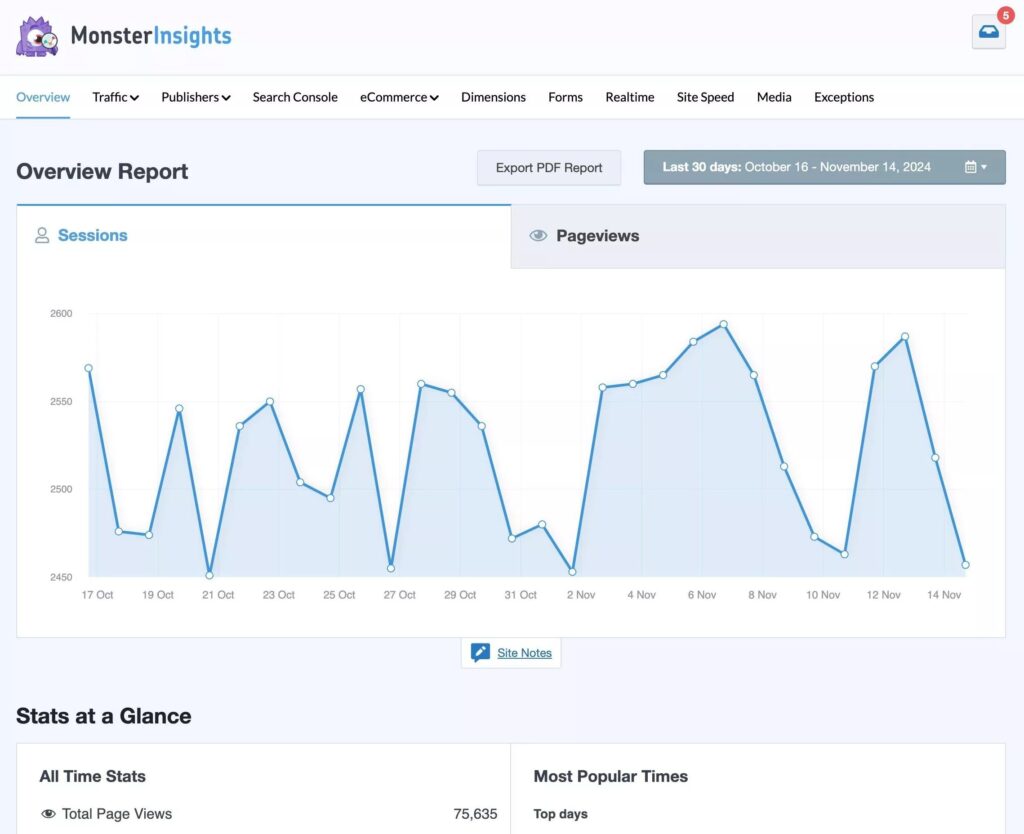
Then, check out the Publishers Report under the Reports menu to see your top-performing posts and pages.
You can also sort by the Avg. Duration to find content that not only gets traffic but keeps visitors on your site.
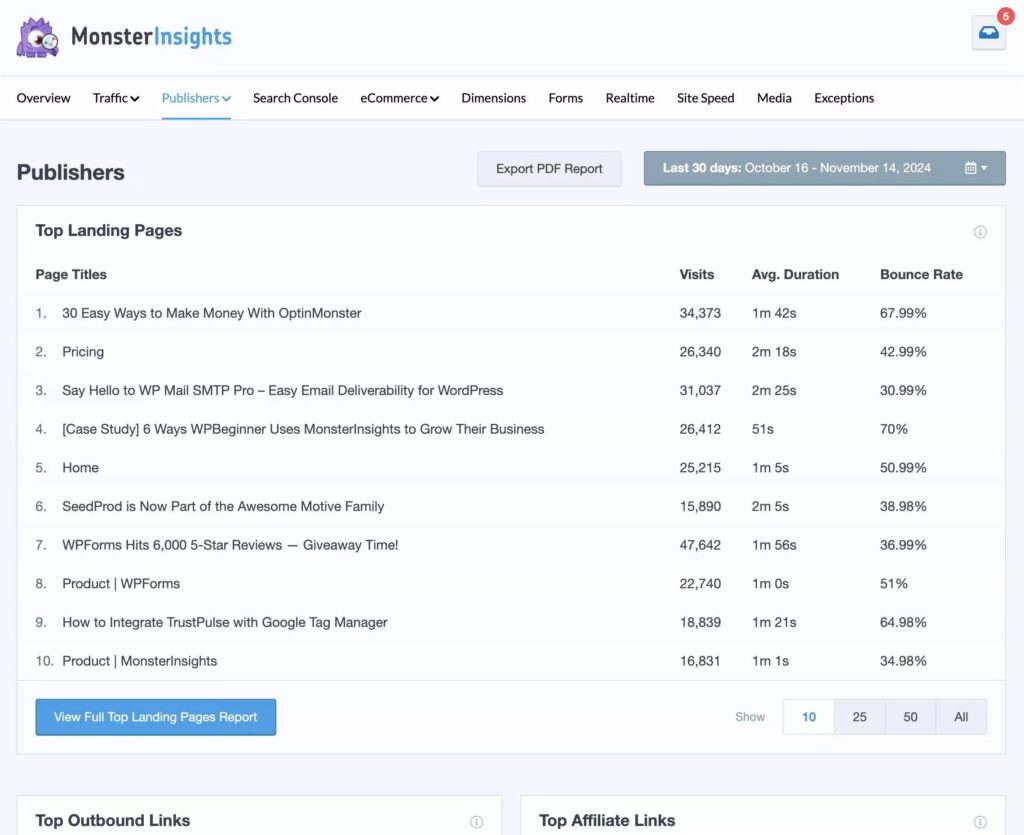
When you are able to identify which posts get steady traffic growth and high engagement month to month, you’ll learn what topics resonate most with your audience.
Once you have this knowledge, you can:
- Expand the content with more comprehensive information
- Create related articles on subtopics
- Update the page with fresh data and examples
- Build more internal links pointing to and from that content
By doubling down on content that’s already trending upward, you amplify what’s working instead of starting from scratch with unproven topics.
Don’t wait for a page to decline before optimizing it. Refresh and expand high-performing content while it’s still rising to maximize its potential.
3. Identify Content Gaps Early
One of the biggest advantages of predictive SEO is spotting content gaps before your competitors do. These are emerging subtopics or questions that people are starting to search for, but few (or no) websites have comprehensively covered yet.
How to find content gaps:
- Use keyword research tools to explore related queries and questions around your main topics
- Look at the “People Also Ask” sections in Google search results for emerging questions
- Monitor your Search Console for queries where you’re getting impressions but low clicks — these indicate topics people want that you haven’t fully addressed
- Check social media, forums, and community sites like Reddit to see what questions people are asking
For example, if you’re in the marketing space and notice people asking about “AI content optimization tools” but very few comprehensive guides exist yet, that’s a predictive opportunity. Create the definitive guide now, before it becomes a saturated keyword.
Finding gaps in your WordPress dashboard
MonsterInsights makes it easy to spot these content gap opportunities. In your Search Console Report, look for queries with high impressions but low clicks. These tell you that people are searching for something you partially cover, but your content isn’t quite hitting the mark yet.
That’s a content gap — and a predictive opportunity to create comprehensive content before competitors realize the demand is there.
The key is acting while competition is still low. Once everyone realizes a keyword is valuable, it becomes much harder to rank.
For more information about finding and improving content gaps, check out the following beginner’s guides:
4. Watch for Shifts in Search Intent
Search intent — the reason behind someone’s search query — constantly evolves. A keyword that used to be informational might become transactional. A broad query might become more specific. These shifts in intent are predictive signals.
Here’s what to watch for:
- Query modifications: Notice when users start adding words like “best,” “how to,” “vs,” or “alternative” to existing searches.
- Format preferences: Pay attention when searches shift from “what is X” to “how to use X” — this signals your audience is moving from awareness to consideration.
- Feature requests: If people start searching for specific features or use cases, that predicts what content you need to create next.
For example, if you’ve been tracking “SEO tools” and suddenly see an uptick in “AI SEO tools” or “SEO tools with AI,” that intent shift tells you it’s time to update your existing content or create new comparisons featuring AI capabilities.
Adapt your titles, headings, internal linking, and content structure to match these evolving search intents before your competitors catch on.
Tracking intent shifts in real-time
Your MonsterInsights Search Console Report updates regularly with new query data, making it easy to spot when search phrases start evolving. Watch for variations of your core keywords appearing in your top queries — these variations often signal intent shifts.
For instance, if you’ve been ranking for “email marketing” and suddenly see “email marketing automation” or “AI email marketing” appearing in your rising queries, that’s your signal to adapt your content strategy accordingly.
5. Predict Revenue and Conversion Opportunities
If you run an eCommerce store or track conversions on your site, predictive SEO can help you forecast which products, services, or pages will drive the most revenue in upcoming months.
For eCommerce sites, analyzing seasonal patterns in your sales data reveals predictive opportunities.
For instance, you might look at:
- Which products or categories saw increased interest last year at this time?
- Which landing pages consistently drive conversions during certain months?
Use this predictive data to:
- Plan content campaigns around products that will trend
- Optimize product pages before seasonal demand spikes
- Create gift guides or buying guides ahead of shopping seasons
- Adjust your eCommerce SEO strategy to focus on high-converting keywords before competition increases
For example, if your analytics show that “eco-friendly office supplies” drives more revenue every September as businesses prepare for the new fiscal year, you can create and optimize related content in July and August — capturing early traffic and building authority before the rush.
Track eCommerce trends in WordPress
With the MonsterInsights eCommerce addon, you can track detailed sales data and spot patterns that predict future opportunities.
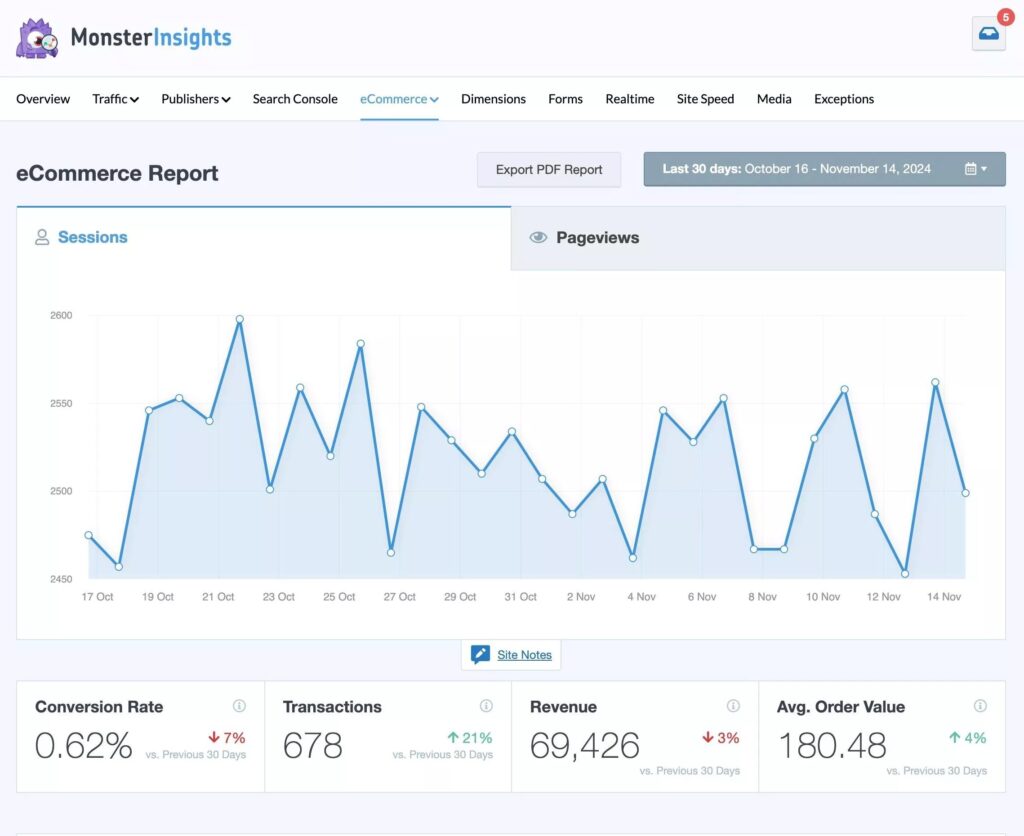
Look at your eCommerce Report and compare seasonal trends using the date comparison feature.
You’ll quickly see which products, categories, or content drive revenue at specific times of the year — giving you the predictive insights you need to plan ahead.
MonsterInsights integrates directly with WooCommerce, Easy Digital Downloads, MemberPress, and other popular platforms, making revenue forecasting as simple as checking your WordPress dashboard.
For more information on this topic, see our detailed guide on effective eCommerce optimization tactics.
6. Use AI to Ask Questions About Your Analytics Data
AI tools like ChatGPT, Claude, and Gemini can be incredibly powerful for predictive SEO. You can feed them keyword data and ask them to brainstorm related topics, predict search intent shifts, or identify emerging keyword clusters.
For example, you might ask: “Based on rising interest in ‘predictive SEO,’ what related keywords and subtopics are likely to trend in the next 6 months?” The AI can generate ideas like “predictive keyword research,” “AI-powered SEO forecasting,” or “how to use analytics for predictive SEO.”
The challenge? These tools don’t have access to your specific website data. You’d need to export your analytics, copy the data into the AI tool, and then manually validate the insights against your actual performance.
The easiest way to brainstorm with AI using your data
Conversations AI by MonsterInsights lets you chat directly with your Google Analytics data — right inside your WordPress dashboard.
Simply navigate to Insights » Conversations AI and start asking questions about your data.
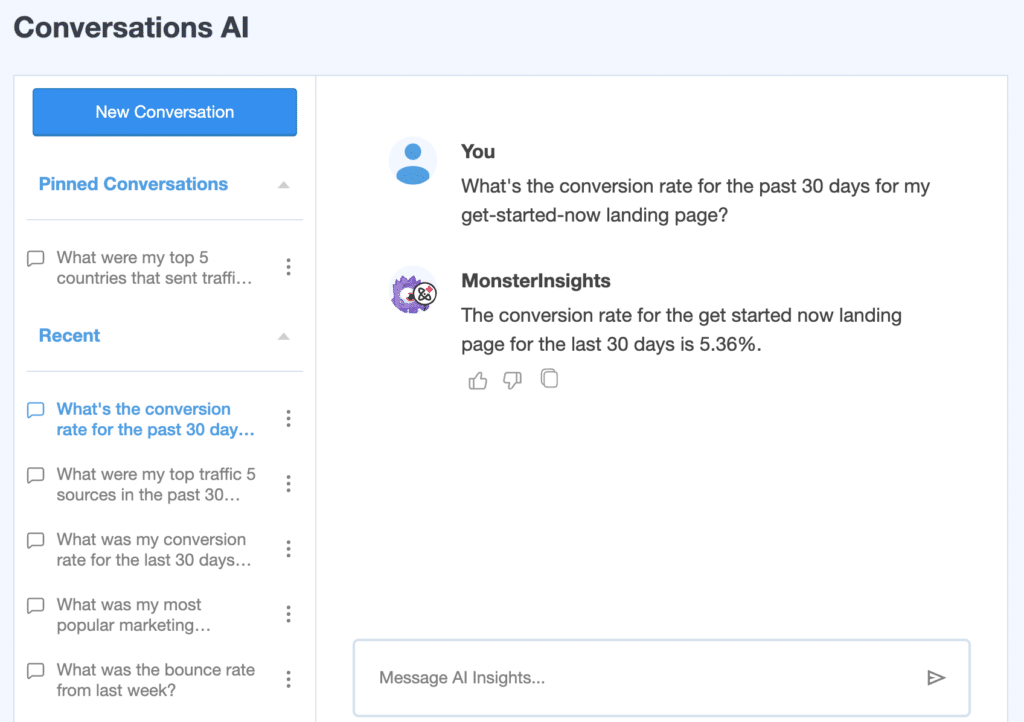
You can ask things like:
- “Which of my blog posts have been gaining the most traffic over the past 3 months?”
- “Show me my top rising search queries from Search Console”
- “What’s my engagement rate trend for [specific page] over the last 6 months?”
- “Which landing pages are getting more conversions this quarter compared to last quarter?”
Conversations AI analyzes your MonsterInsights and Google Analytics data to give you instant answers — no exporting, no copying data, no manual validation required.
You can even request graphs and visualizations to spot trends more easily.
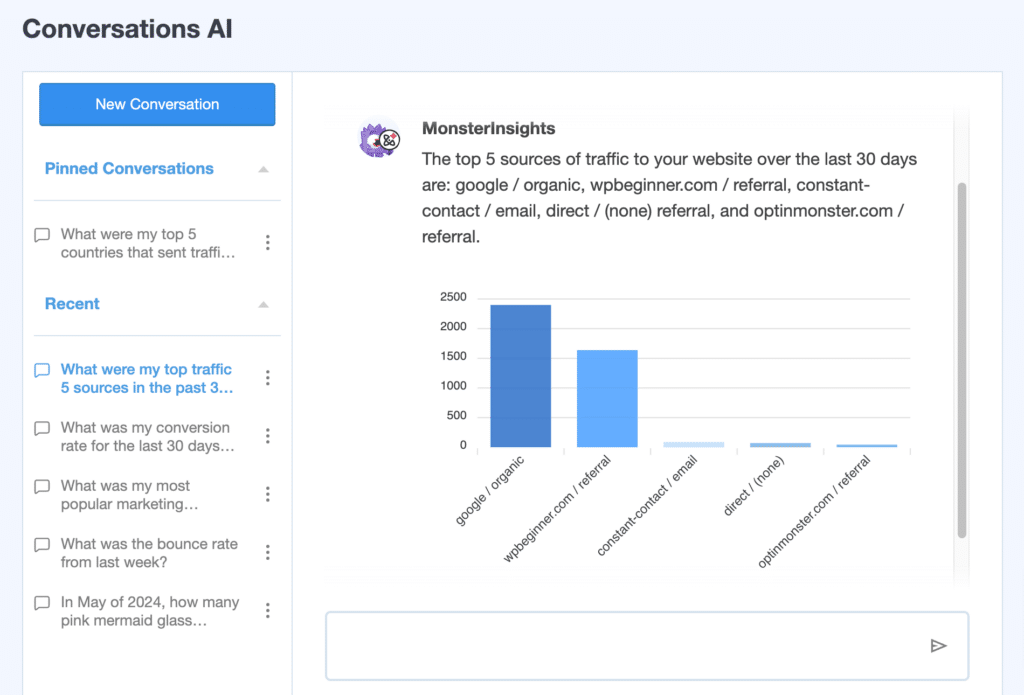
For example, if Conversations AI reveals that your posts about “AI marketing tools” have seen 150% traffic growth over the past quarter, that’s a strong predictive signal.
You can immediately ask follow-up questions to validate whether that traffic is engaged and whether the trend is likely to continue.
Want even more automatic insights? If you have MonsterInsights Plus or above, you also get access to AI Insights — a tool that automatically spots trends and anomalies in your data without you even asking.
Simply click Insights » AI Insights to see automatic observations about what’s happening with your website traffic.
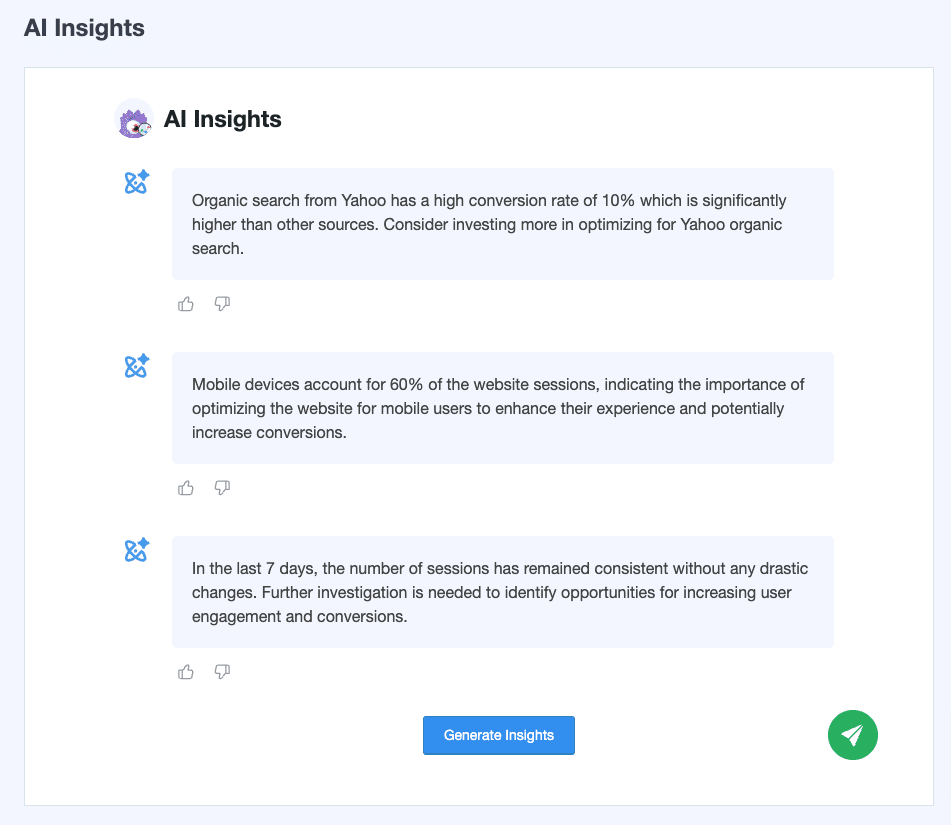
Whether you use external AI tools or Conversations AI, remember: AI is excellent at pattern recognition and brainstorming, but always validate predictions with real analytics data before investing time in content creation.
💡 Ready to chat with your analytics and spot trends faster?
Get started with MonsterInsights Pro to access Conversations AI today.
Frequently Asked Questions About Predictive SEO
What is predictive SEO in simple terms?
Predictive SEO is the practice of using data analysis and trend tracking to forecast which keywords, topics, and content types will become popular in the future. Instead of waiting to see what’s working after the fact, predictive SEO helps you anticipate search trends and create or optimize content before those trends peak. This gives you a competitive advantage by allowing you to rank early and establish authority before the topic becomes crowded.
Is predictive SEO the same as AI SEO?
Not exactly, though they’re related. AI SEO typically refers to using artificial intelligence tools to help with content creation, optimization, and analysis. Predictive SEO is the broader strategy of forecasting future search trends and opportunities. While AI can certainly power predictive SEO (by analyzing patterns and suggesting trends), predictive SEO focuses on using historical data, analytics, and trend analysis to anticipate what’s coming next — whether you’re using AI tools or not.
Can small businesses use predictive SEO?
Definitely! Predictive SEO isn’t just for large enterprises with big analytics teams. Small businesses can actually benefit even more from predictive SEO because it helps you compete smarter, not harder. Even basic analytics tools like Google Analytics and Search Console contain all the trend data you need to spot opportunities early. The key is consistently reviewing your data and acting on rising trends before they become mainstream. Tools like MonsterInsights make this even easier by showing you predictive insights right in your WordPress dashboard.
How often should I analyze trends for predictive SEO?
Monthly reviews work best for most websites. Check your analytics, Search Console queries, and keyword trends at least once per month to spot rising opportunities. During these monthly reviews, look for patterns in traffic, engagement, and search impressions. Then, conduct more comprehensive quarterly strategy reviews where you step back and look at bigger picture trends, adjust your content calendar, and plan for seasonal opportunities. The key is consistency — predictive SEO only works when you’re tracking data over time.
What tools do I need for predictive SEO?
You don’t need expensive or complicated tools to get started with predictive SEO. The essentials include Google Analytics (for traffic and engagement data), Google Search Console (for keyword and ranking data), and Google Trends (for spotting rising interest in topics). If you’re using WordPress, MonsterInsights brings all this data together in one dashboard and makes trend spotting much easier. As you get more advanced, you might add dedicated keyword research tools or AI assistants, but you can accomplish a lot with free tools and consistent analysis.
How far in advance can I predict search trends?
Most predictive SEO focuses on forecasting 3-6 months ahead. This timeframe gives you enough lead time to create comprehensive content, build topical authority, and establish rankings before trends peak — while still being close enough that predictions remain accurate. Some seasonal trends can be predicted a year in advance based on historical patterns, while rapid-moving topics might only give you a few weeks’ notice. The key is matching your prediction timeline to your content creation capacity and industry speed.
That’s it! You now know exactly what predictive SEO is, why it matters, and how to start implementing it on your own website.
Ready to start practicing predictive SEO? Get started with MonsterInsights to see all your predictive analytics data in one simple WordPress dashboard.
If you found this guide helpful, here are a few more articles you might want to check out:
- How to Do Keyword Research for SEO: Quick-Start Guide
- Organic Search in Google Analytics: Quick-Start Guide
- Search Engine Ranking Reports: Tools & Tips for SEO
- WooCommerce SEO Tips to Increase Search Rankings Today
Not using MonsterInsights yet? What are you waiting for?
Don’t forget to follow us on YouTube for more helpful Google Analytics tips, SEO tutorials, and WordPress guides.
